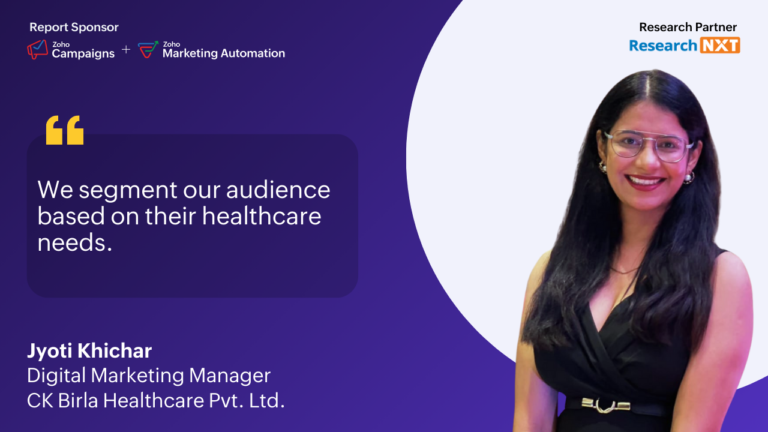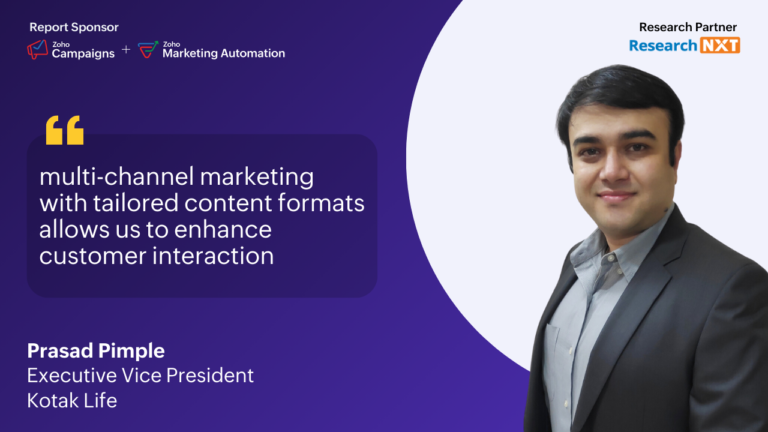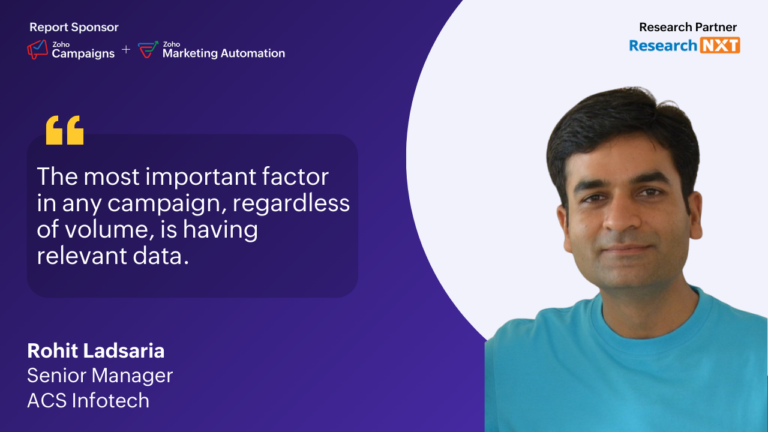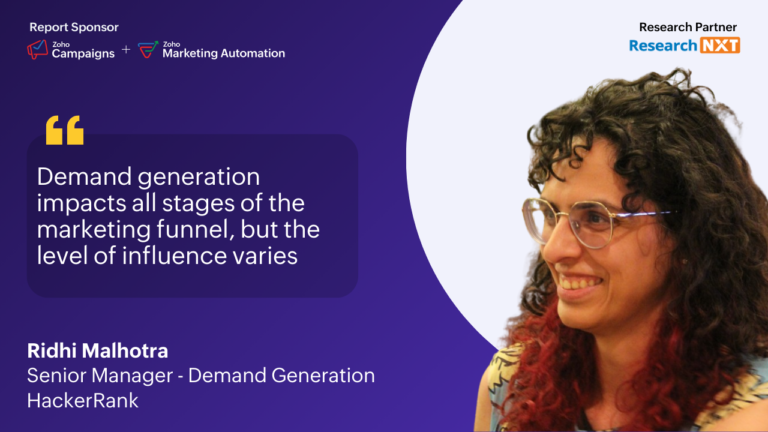
Crafting Authentic Digital Strategies in Higher Education: Insights from Ashoka University’s Marketing Leader
In this interview with Research NXT, Anju Singh, Deputy Manager of Digital & Social Media Marketing at Ashoka University, shares her professional journey, which honed her adaptability and decision-making skills. Her role has evolved from execution to strategy development, focusing on both organic and paid campaigns across social media and email. She emphasises the importance of platform-specific content and consistently monitors engagement metrics like saves, shares, and reposts to fine-tune their strategies. AI tools have become essential in streamlining content creation and research. She also highlights the challenge of maintaining credibility in digital marketing, cautioning against misleading educational practices that focus on tools over actual marketing strategy.
Key Takeaways
- Ashoka University leverages a multi-channel approach, focusing on LinkedIn and Instagram for organic reach and Google/Facebook ads for paid campaigns.
- Personalisation and understanding audience psychology are crucial for effective engagement, especially in education marketing.
- AI tools are being utilised to streamline content creation and research processes.
- ROI measurement differs for organic (brand awareness metrics) vs. paid (direct conversions) campaigns
- There’s a concerning trend of misleading digital marketing courses in the industry, emphasising the need for comprehensive, practical education.
"Our main objective is to increase brand awareness across different programs, each of which targets specific age groups."
Please tell us about your professional journey that led to your position as Deputy Manager of Digital & Social Media Marketing at Ashoka University. What experiences were most crucial in preparing you for this role?
Anju: I began my marketing career in 2019, working with startups across various sectors, such as business, education, and real estate. Startups taught me the importance of taking responsibility and making quick decisions since there’s often no rigid hierarchy. This allowed me to plan, execute, and learn rapidly, shaping my adaptability and work ethic.
Before the COVID-19 pandemic, my skills focused heavily on presentations, in-person communication, and tools like MS Excel and PowerPoint. These were essential for managing projects and clients. However, as the marketing landscape evolved during the pandemic, so did my skill set. I delved deeper into areas like graphic design, branding, SEO, copywriting, content creation, and more. I learned that branding is more than just a logo—it’s about how a brand communicates with its audience.
I expanded my knowledge through various sources, including YouTube, courses, and insights from co-founders I worked with. This exploration helped me adapt to the fast-changing digital landscape. Later in my career, when I joined more established companies, I gained experience in paid marketing (specifically Facebook and LinkedIn ads) and email marketing using tools like MailChimp and Brevo. All of these experiences and skills now play a vital role in my current work.
What are your primary responsibilities as the Deputy Manager of Digital & Social Media Marketing at Ashoka University?
Anju: In my current role, I initially focused more on execution, particularly using tools like Google Ads. While I contributed ideas, the overall strategy was mostly determined by upper management. My primary responsibility was to implement the strategy, manage the tools, monitor performance, and share reports.
Over the past 9-10 months, my role has evolved significantly. I am now more involved in strategy development, collaborating closely with the product development team to better understand the programs being created for different student segments, such as high school and university students. This deeper understanding allows me to craft more effective, value-driven content rather than simply focusing on sales-oriented messaging.
My role also includes managing both organic and paid campaigns. Paid campaigns are launched seasonally, depending on the program schedule, while organic efforts, like social media and SEO, remain ongoing. Overall, my responsibilities now revolve around strategy, content creation, and campaign management across both organic and paid channels.
Read More
Are the campaigns you’re managing mainly focused on social media channels, or are you also working on email and other channels as well?
Anju: We initially posted across multiple social media platforms, including YouTube, Twitter, Facebook, Instagram, and LinkedIn. However, after analysing the results over a few months, I noticed that organic content on Facebook wasn’t effective for our audience. I shared these insights with senior management, and we shifted our focus to LinkedIn and Instagram, where our target audience—parents, educators, counsellors, and high school students—is most active.
Instagram is ideal for reaching students with fun, engaging content like trending audio and reels. On LinkedIn, we focus on educators and parents, where the platform is more effective for professional and parental engagement. We also rely heavily on email for communication and webinars, which remains a crucial channel for us.
One fundamental shift I recommended was creating platform-specific content instead of reposting the same material across all platforms. For example, on Instagram, we prioritise reels and lighter content, while on LinkedIn, we focus more on static images or carousel posts with informative text. This approach has proved successful in improving our reach and engagement.
What are the main objectives of Ashoka University’s social media campaigns?
Anju: Our main objective is to increase brand awareness across different programs, each of which targets specific age groups. For example, we manage separate social media handles for university-level programs and other age-specific offerings. Beyond brand awareness, we aim to provide value-driven content. One key focus is preparing students for better college applications by giving insights into university-level education and helping high school students make informed decisions about their future academic paths. We strive to ensure that our social media content offers real value, not just program details.
How do you ensure that the content you create resonates with Ashoka’s diverse audience, including prospective students, parents, and academic professionals?
Anju: As I mentioned, each program we offer for different age groups has its own dedicated social media handle. It’s not like Ashoka University has just one handle for all audiences. However, the main Ashoka University account occasionally collaborates with these program-specific handles when the content aligns. This allows each program to cater directly to its specific target audience while still benefiting from broader exposure through collaboration.
Which tools or platforms do you use for automating repetitive tasks like content scheduling, email campaigns, or audience segmentation?
Anju: For our email campaigns, we use a tool, particularly for automating communications like webinar reminders and event updates, which helps streamline the process and reduces manual efforts. For example, follow-up emails or “one day to go” reminders are automated to ensure timely delivery. However, for communications that require a more personal touch, we handle those manually to ensure they receive the necessary attention.
To get a sense of the scale at which you’re operating, considering you have both existing and prospective students you’re reaching out to, what is the approximate size of your email database at any given time?
Anju: The size of our email database varies depending on the specific program. For example, programs for high schoolers, such as summer or pre-college programs, are often seasonal and time-specific, so the database fluctuates accordingly.
However, the numbers can differ based on the program’s popularity. For instance, the Ashoka Young Scholars Program, a well-known residential program for high schoolers, has a much larger email database due to its popularity, especially within premium schools. On the other hand, newer programs like Ashoka Horizons, an online offering for high schoolers, have a smaller database since it’s relatively new and faces more competition.
With potential overlap between your social media followers and email database, how do you identify individuals who engage across multiple channels as the same person? Additionally, how do you track their lifecycle to deliver relevant content and move them further down the funnel?
Anju: This is indeed a challenge, and we haven’t completely solved it yet, though we’re continually working to improve. For example, in our paid ads, we track the user journey using Google Analytics, which allows us to see when a user clicks an ad, visits a page, and clicks on the “apply now” button. Once an application form is submitted, we manually match the data in Excel.
We’re also in discussions about integrating a particular AI tool to further automate and streamline the process. I’ve used a similar tool in a previous role at a real estate company, and it significantly reduced manual efforts by automating much of the tracking. We’re considering implementing a similar system here to improve automation and efficiency, but for now, much of the tracking still involves manual steps.
How do you personalise your digital marketing strategies to cater to Ashoka University’s various stakeholders? What role does engagement play in fostering a deeper connection between the university and its online community?
Anju: In addition to marketing efforts, the popularity of our programs, such as the Young Scholars Program, plays a significant role in our success. These programs are well-known within the community and schools, which helps drive organic interest. For example, during our recent Young Scholars Program, we shared regular updates on social media, particularly Instagram, which led to a significant increase in engagement without any paid promotion.
What made this particularly effective was understanding the audience’s desires. Parents contacted us through DMs, asking for posts featuring their children, showing their eagerness to stay connected with the program remotely. We responded by tailoring our content to meet those requests, using various formats like reels and carousels to keep it engaging.
One parent’s feedback summed it up well, praising our marketing for its deep understanding of the audience and our ability to present content that truly resonates. This highlights the importance of knowing your audience and adapting your content to meet their expectations.
How has AI impacted your audience engagement and personalisation strategies? Are you using AI-powered tools to help with audience segmentation or content personalisation?
Anju: We’re definitely in the AI era, and AI is playing a significant role in our business. For example, in paid ads like Google Ads, AI helps optimise creatives and copy, improving performance. While that feature isn’t new, AI is now helping us in more advanced ways, particularly in daily tasks like copywriting and research.
Tools like Copy.ai and ChatGPT are speeding up our copywriting process, allowing us to experiment with different versions more efficiently. We’re also using AI-driven research tools like Perplexity to streamline the research process, which saves time and lets us focus more on creative strategy.
In addition, we’re exploring DALL·E within ChatGPT, particularly for online programs where we don’t have a physical campus to showcase. These AI tools help us enhance our content creation and generate more compelling copies and visuals, ultimately improving efficiency and creativity in our campaigns.
From a social media perspective, are there specific strategies that have worked well for engagement that you’ve been able to replicate across campaigns? For example, do you consider factors like timing, messaging, or content formats that have proven successful?
Anju: For social media, we focus on scheduling posts at consistent times, typically using Instagram and LinkedIn’s native scheduling features. Posting at regular intervals, like Monday, Wednesday, and Friday, helps with engagement and platform algorithm visibility. We’ve noticed that educators and counsellors, our primary audience, are more active on LinkedIn during weekdays, so we avoid posting on weekends or late Fridays.
One tactic that has worked well is responding to DMs or comments right after posting new content. This seems to boost the visibility of the post in the user’s feed, increasing engagement.
For email campaigns, we automate follow-up emails within the same thread with “RE” in the subject lines, keeping the communication continuous rather than sending entirely new emails. We also keep the tone conversational, especially when addressing specific groups like high schoolers, to make the message feel more approachable.
How do you measure the success of your digital and social media campaigns? What KPIs do you find most valuable in the context of higher education?
Anju: From both organic and paid perspectives, our approach varies. Organic efforts are ongoing, even though our programs are seasonal. For organic content, we track metrics such as engagement rate, impressions, and reach. On Instagram, we focus on saves and shares for value-driven content, as these metrics help us understand whether the content is resonating with the audience. If content is frequently saved or shared, it indicates value; if not, we adjust our strategy.
We also use trending audio in Instagram reels to boost reach, monitoring impressions to see if the tactic is working. On LinkedIn, we measure the success of posts by tracking reposts, especially from key individuals like founders, educators, and academicians. Reposts show that the content is valuable enough to share with their networks, and we aim to replicate that success while reducing content that doesn’t perform as well.
When it comes to paid ads, especially during enrollment periods, our primary focus is on conversions. While we track other metrics, the main goal is to ensure that the resources, time, and effort invested are delivering a strong ROI.
Your marketing strategy shows maturity by not solely focusing on conversions but also measuring brand awareness through organic efforts. Is there a tool you’re using to capture and track these metrics, or are you manually gathering this data and creating your own dashboard?
Anju: We use Google Analytics to track performance and create unique UTM links for each Instagram post. These links are placed in the “link in bio.” When a post performs well based on metrics like shares or saves, we analyse the UTM link to track user interactions with our website. This helps us understand how users engage with our content beyond social media.
Before we wrap up, we want to know your expectations from this report. What do you think would be most valuable for the readers of the report?
Anju: I don’t have specific expectations, as you’ve been doing this for a long time and understand what your readers want. However, I’ve noticed a concerning trend in digital marketing education where many instructors misguide students. They promise high-paying jobs after completing courses but fail to deliver, leaving students disillusioned and damaging the reputation of the field.
Some focus only on basic, copy-paste tactics like backlinks, presenting them as complete digital marketing. Others teach tools but fail to cover crucial aspects like marketing psychology and understanding audience behaviour. Knowing how to use tools like Google Ads isn’t enough. When students apply this knowledge and don’t see results, it can be demotivating, making them doubt their own abilities.
There seems to be a gap in the industry where those with genuine knowledge understand the field, but others are misguiding people. This gap is damaging the industry’s reputation and undermining its credibility.
True digital marketing is much more than just using tools—it’s about understanding strategy and effectively connecting with audiences.






